How Arturo Vega retrospective came to be
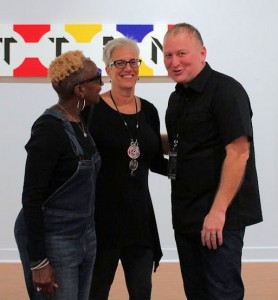 On view now through December 17 at the Bob Rauschenberg Gallery on the Lee campus of Florida SouthWestern State College is Empire: Arturo Vega Retrospective. The origins of the show date back, strangely enough, to 1992. Back then, Gallery Director Jade Dellinger was a grad student at NYU living on 3rd Avenue and 9th Street in the East Village.
On view now through December 17 at the Bob Rauschenberg Gallery on the Lee campus of Florida SouthWestern State College is Empire: Arturo Vega Retrospective. The origins of the show date back, strangely enough, to 1992. Back then, Gallery Director Jade Dellinger was a grad student at NYU living on 3rd Avenue and 9th Street in the East Village.
“I was up and down the Bowery with great frequency,” writes Jade in the catalogue for the show. “CB’s 313 Gallery presented an exhibition of Arturo Vega’s Insults, and, although the vitality of anything artistic 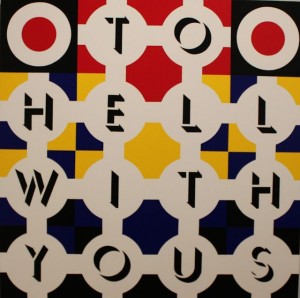 around CBGB seemed to have long since diminished, this particular visual art show resonated and enticed me back for repeat visits. At the time, I knew little if anything about the artist or his rather profound relationship to that historic place, but his paintings (as verbally abusive as they seemed) clearly spoke to me.”
around CBGB seemed to have long since diminished, this particular visual art show resonated and enticed me back for repeat visits. At the time, I knew little if anything about the artist or his rather profound relationship to that historic place, but his paintings (as verbally abusive as they seemed) clearly spoke to me.”
About five years later, Jade began assembling an archive and building a personal collection of punk-era artifacts. He amassed boxes of Devo-related material while researching a book he co-authored 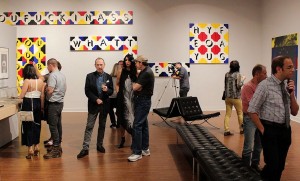 about the band. But he was also feverishly tracking down significant memorabilia from other bands as well. “In July of 1999, Dee Dee, Tommy, Johnny, Joey, Marky and C.J. Ramone made a special appearance at the Virgin Megastore on Union Square for the release of their Rhino Records anthology,” continues Dellinger in the show
about the band. But he was also feverishly tracking down significant memorabilia from other bands as well. “In July of 1999, Dee Dee, Tommy, Johnny, Joey, Marky and C.J. Ramone made a special appearance at the Virgin Megastore on Union Square for the release of their Rhino Records anthology,” continues Dellinger in the show 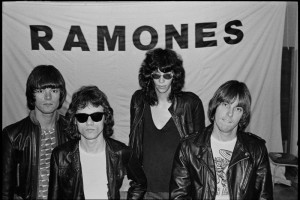 catalogue. “After years of random neighborhood sightings (primarily of Joey – who at 6 feet, 6 inches was always hard to miss), I had the opportunity to finally meet them all in a single unforgettable evening (along with tour manager Monte Melnick and crew). When the Ramones were welcomed into the Rock & Roll Hall of Fame a few years later, I lent a number of items –
catalogue. “After years of random neighborhood sightings (primarily of Joey – who at 6 feet, 6 inches was always hard to miss), I had the opportunity to finally meet them all in a single unforgettable evening (along with tour manager Monte Melnick and crew). When the Ramones were welcomed into the Rock & Roll Hall of Fame a few years later, I lent a number of items – 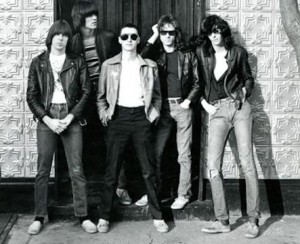 including the classic Arturo Vega-designed Ramones t-shirt that was once owned (a highly-prized possession) and stage-worn by the Sex Pistols’ late bassist Sid Vicious – for the display celebrating the band’s 2002 induction.
including the classic Arturo Vega-designed Ramones t-shirt that was once owned (a highly-prized possession) and stage-worn by the Sex Pistols’ late bassist Sid Vicious – for the display celebrating the band’s 2002 induction.
Arturo Vega was not only a long-time friend of the band, he served as their art director as well. “Arturo Vega was the foremost authority, trusted spokesperson and gatekeeper for the band. He 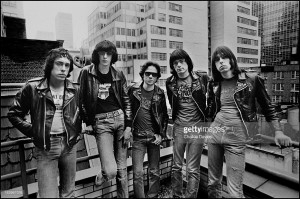 often interacted with fans, managing their official website, so I corresponded with him occasionally in the decade that followed the Ramones’ retirement. I enthusiastically reached out once more in 2011, when I had the good fortune to acquire a 5 x 20 plus feet handpainted canvas banner that Arturo created in the 70s as the primary backdrop for the Ramones club dates. He expressed
often interacted with fans, managing their official website, so I corresponded with him occasionally in the decade that followed the Ramones’ retirement. I enthusiastically reached out once more in 2011, when I had the good fortune to acquire a 5 x 20 plus feet handpainted canvas banner that Arturo created in the 70s as the primary backdrop for the Ramones club dates. He expressed 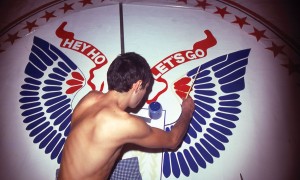 enthusiasm for my find and confirmed the authenticity and provenance of my acquisition. Arturo sent me the catalog for his upcoming exhibition at Galeria OMR in Mexico City and wrote, ‘It’s very cool how you and I share interests in Art and the Ramones … I hope we can meet soon and talk and work on something together.”
enthusiasm for my find and confirmed the authenticity and provenance of my acquisition. Arturo sent me the catalog for his upcoming exhibition at Galeria OMR in Mexico City and wrote, ‘It’s very cool how you and I share interests in Art and the Ramones … I hope we can meet soon and talk and work on something together.”
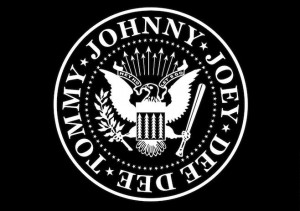 Regrettably, that never transpired. Vega died in 2013 before he and Dellinger had an opportunity to meet or collaborate on common project. But earlier this year, Jade received an invitation from Howl! Happening in New York to contribute an essay to a catalog they were preparing for a posthumous solo show of Arturo’s Insults paintings that Howl! was getting ready to exhibit.
Regrettably, that never transpired. Vega died in 2013 before he and Dellinger had an opportunity to meet or collaborate on common project. But earlier this year, Jade received an invitation from Howl! Happening in New York to contribute an essay to a catalog they were preparing for a posthumous solo show of Arturo’s Insults paintings that Howl! was getting ready to exhibit. 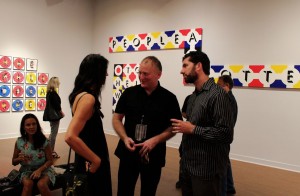 That invitation provided the impetus for Dellinger to do something with Vega “even if simply collaborating in his absence with those who represent him so thoughtfully at the Arturo Vega Foundation.”
That invitation provided the impetus for Dellinger to do something with Vega “even if simply collaborating in his absence with those who represent him so thoughtfully at the Arturo Vega Foundation.”
And so Jade readily and happily acknowledges that this first-ever U.S. museum retrospective “simply 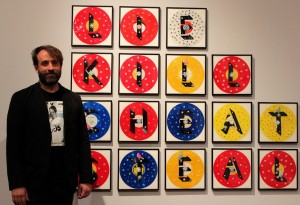 would not have been possible without the tireless efforts of Ted Riederer (right) of Howl! Happening: An Arturo Vega Project, and the vision, passion, unwavering commitment and support of Jane Friedman at the helm of the late artist’s foundation. I am grateful to both for the opportunity, and honored to present this important body of work at the Bob Rauschenberg
would not have been possible without the tireless efforts of Ted Riederer (right) of Howl! Happening: An Arturo Vega Project, and the vision, passion, unwavering commitment and support of Jane Friedman at the helm of the late artist’s foundation. I am grateful to both for the opportunity, and honored to present this important body of work at the Bob Rauschenberg 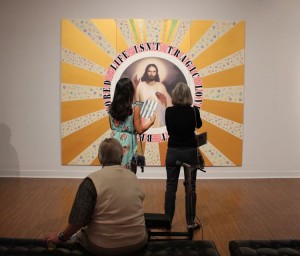 Gallery at FSW.”
Gallery at FSW.”
And now you know how it came to be the Empire: Arturo Vega Retrospective came to fruition. In a future post, you will learn why the exhibition is significant in the context of Robert Rauschenber and the legacy he left behind when he died on May 12, 2008.
November 6, 2016.
RELATED POSTS.
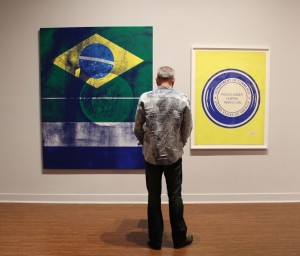 Arturo Vega retrospective to open at Rauschenberg Gallery on November 4
Arturo Vega retrospective to open at Rauschenberg Gallery on November 4- About Arturo Vega
- Rauschenberg Gallery hosts Arturo Vega panel discussion November 5 at 1:00 p.m.














 Tom Hall is both an amateur artist and aspiring novelist who writes art quest thrillers. He is in the final stages of completing his debut novel titled "Art Detective," a story that fictionalizes the discovery of the fabled billion-dollar Impressionist collection of Parisian art dealer Josse Bernheim-Jeune, thought by many to have perished during World War II when the collection's hiding place, Castle de Rastignac in southern France, was destroyed by the Wehrmacht in reprisal for attacks made by members of the Resistance operating in the area. A former tax attorney, Tom holds a bachelor's degree as well as both a juris doctorate and masters of laws in taxation from the University of Florida. Tom lives in Estero, Florida with his fiancee, Connie, and their four cats.
Tom Hall is both an amateur artist and aspiring novelist who writes art quest thrillers. He is in the final stages of completing his debut novel titled "Art Detective," a story that fictionalizes the discovery of the fabled billion-dollar Impressionist collection of Parisian art dealer Josse Bernheim-Jeune, thought by many to have perished during World War II when the collection's hiding place, Castle de Rastignac in southern France, was destroyed by the Wehrmacht in reprisal for attacks made by members of the Resistance operating in the area. A former tax attorney, Tom holds a bachelor's degree as well as both a juris doctorate and masters of laws in taxation from the University of Florida. Tom lives in Estero, Florida with his fiancee, Connie, and their four cats.